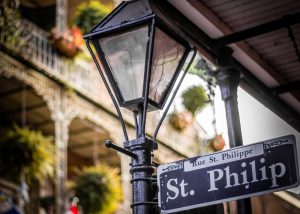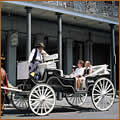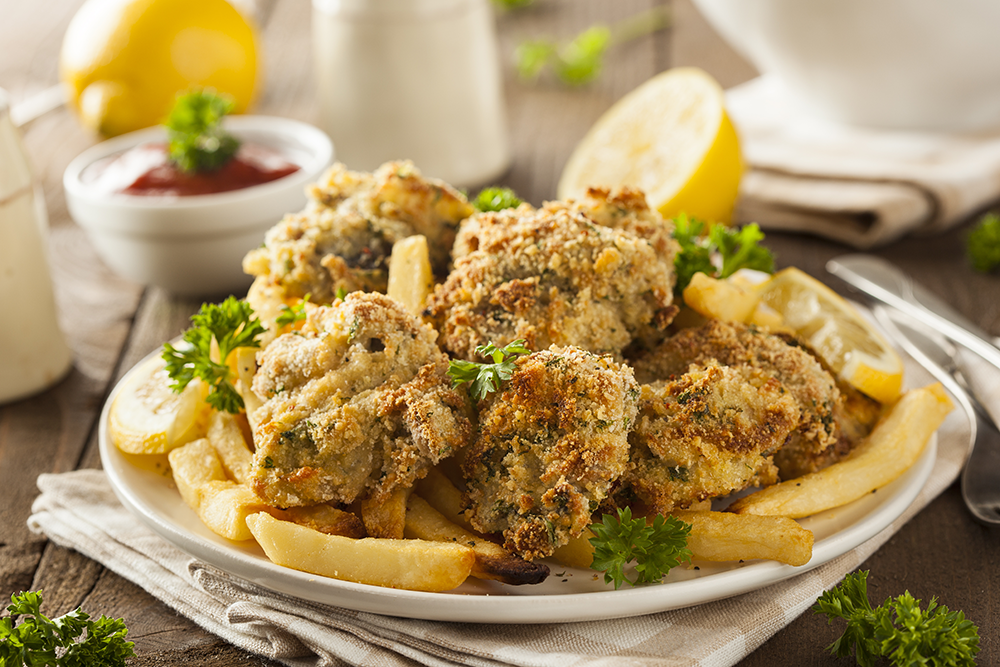Vegetarian Destinations in the French Quarter
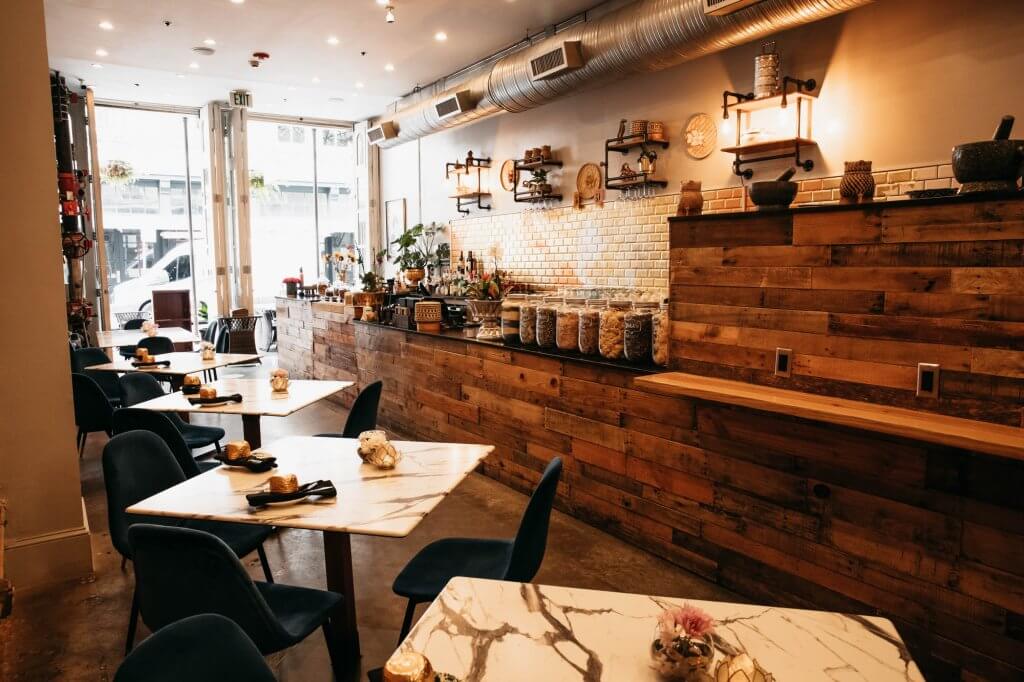 Photo courtesy of Thaihey NOLA on Facebook
Photo courtesy of Thaihey NOLA on Facebook
Crawfish boils, alligator boudin balls, deep-fried frogs’ legs — if there’s a swamp creature that swims, flies or skitters, chances are a Louisianan has turned it into something delicious. That ingenuity put New Orleans on the culinary map — but as far as the vegetarian radar goes? Not so much.
It hasn’t always been easy to go meat-free in New Orleans, but recent years have seen an influx of vegetarian options that are more than an afterthought. The following restaurants don’t serve plant-based meals exclusively, but they all put thoughtful preparation into their meatless fare. (Which comes as quite a relief for vegetarians who have eaten one too many bland grilled vegetable platters.)
Bennachin
1212 Royal St.
You might have sampled Bennachin’s legendary mburu akara (black-eyed pea fritters and tomato stew on French bread) and jama jama ni makondo (sautéed spinach, fried plantains and coconut rice) at Jazz Fest, where the longtime spot for African fare has a perennial presence. The food tastes even better when consumed in the cozy, colorful French Quarter destination. Bonus: A BYOB policy makes Bennachin an excellent place to affordably wine and dine.
Café Amelie
900 Royal St.
How about an iconic culinary experience in one of the most gorgeous courtyards in the French Quarter (and that’s saying a lot, as the Quarter is full of tropical lushness)? Many items on the menu would pair well with Amelie’s seasonally inspired cocktails, and the locally sourced ingredients speak for themselves. You’ll see quite a few items on the menu marked with “V” for vegetarian that go beyond salads, like elevated roasted vegetables and gnocchi.
Café Cour
520 Royal St.
The Historic New Orleans Collection’s exhibition center includes a museum café. Café Cour, run by Dana and Christina Honn, who also own the excellent Carmo in the Warehouse District, is named for the famous Seignouret-Brulatour Courtyard, where the café is located. The place showcases the region’s multicultural culinary influences and offers gluten-free, vegetarian, pescatarian, and vegan options. Try the veggie muffuletta, muffulettu giardino, or black-eyed pea fritters (calas).
Crêpes à la Cart
Multiple locations
This food truck popup does have a walk-up counter Uptown, but the truck itself can pop up anywhere. There are over 50 varieties of sweet and savory options on the locally themed menu, many vegetarian or vegans. Catch if you can as it will be worth it. The popup often stays open past midnight, another plus.
Cuñada
833 Conti St.
All vegetarian and vegan dishes are marked as such on the menu, like sopa de tortilla, a fiesta vegetariana plate, and more. There’s also a daily happy hour that starts at 11 a.m. and an agave bar. Cuñada (“sister-in-law” in Spanish) is family-owned. Open til midnight every night.
Gumbo Shop
630 St. Peter St.
True to its name, Gumbo Shop serves up several types of classic gumbo laden with meat and seafood. What makes it stand apart from many other excellent restaurants in the French Quarter that serve up mouth-watering gumbo is that it also has gumbo z’herbes. Gumbo z’herbes is not easy to find on the New Orleans restaurant menus, so unless you venture out to Tremé to sample Leah Chase’s legendary version at her restaurant, Dooky Chase’s, the Gumbo Shop might be your only chance to try this veggie version within the confines of the French Quarter. And try you should, as it’s made with green stock and with various delicious greens, such as mustard or collard, turnips, and spinach.
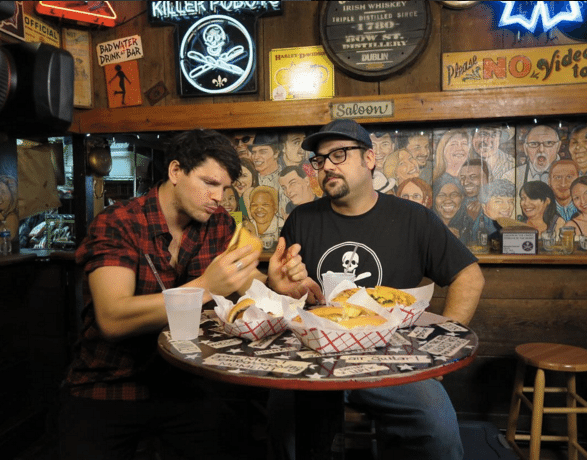 Photo courtesy of Killer Poboys on Facebook
Photo courtesy of Killer Poboys on Facebook
Killer PoBoys
219 Dauphine St.
Launched as a pop-up inside Erin Rose (the original location is still operating from the rear of that bar at 811 Conti St.), Killer PoBoys has also opened a standalone, counter-serve restaurant. The Killer PoBoys’ rotating menu represents an inventive yet respectful take on the classic New Orleans staple. The veggie versions usually include roasted sweet potato, roasted cauliflower, Thai BBQ tofu, and whatever else is seasonally and locally sourced. The decadent whiskey grilled cheese and pecan butter and jelly po-boys are among the mainstays.
Meals From the Heart Cafe
French Market; 1100 N. Peters St.
The back-alley French Market spot is worth the trip for its hard-to-find vegan okra gumbo alone, but its health-conscious menu is full of vegan and gluten-free riffs on other New Orleans classics that usually come only in meat and seafood versions, like the popular Beyond Burger (also soy-free), and the vegan crabcake and Portobello mushroom po-boys.
Thaihey NOLA
308 Decatur St.
Thaihey NOLA describes its menu as Novel Thai Cuisine. Several regions of Thailand are represented, including vegan and vegetarian dishes such as vegan boat noodle, tofu satay and pumpkin curry. In fact, the vegan menu is listed separately, that’s how serious the restaurant is about it.
The Italian Barrel
1240 Decatur St.
Intimate and candlelit, with brick walls and cozy tables, this corner restaurant with sidewalk seating provides all the romance you’d expect from an Italian spot. The tomatoes and basil bruschetta is mouth-tinglingly fresh, and a creamy truffle and porcini sauce blankets excellent, house-made ravioli, but you can’t go wrong with almost any menu option. (Reservations recommended.)
Are you planning to spend some time in New Orleans soon? To stay close to all the action, book a historic boutique hotel in the French Quarter at FrenchQuarter.com/hotels today!
Related Articles
JOIN THE NEWSLETTER!
The Best Places for Oysters in the French Quarter and Nearby
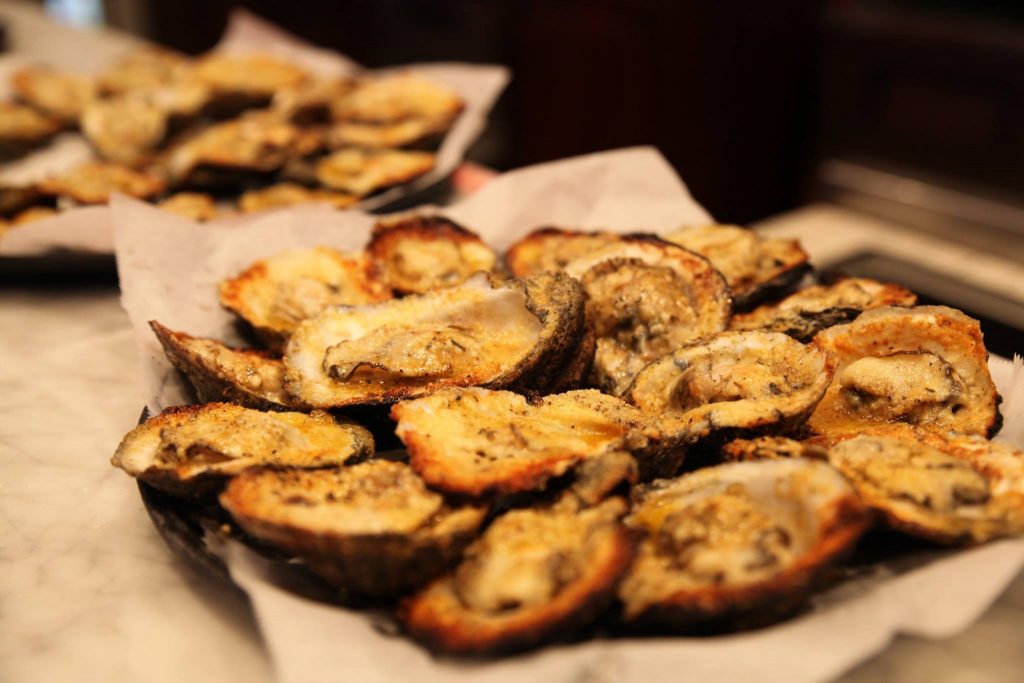
Photo courtesy of Acme Oyster House – French Quarter on Facebook
New Orleans is one of the USA’s great oyster cities, and perhaps the best location for devouring those jewel-like bivalves. While other parts of the country may boast more variety of oysters — here, we generally stick to our Gulf Coast local catch — it’s hard to beat New Orleans for its sheer volume of shellfish and variety of cooking methods.
Look, we agree that an oyster is best when served raw, but nowhere else in this country — maybe the world — can beat the Crescent City when it comes to frying shellfish, and that’s to say nothing of tricks like Oysters Rockefeller, which we invented. Finally, the oyster is the supreme food of the hedonist, long believed to stoke both appetite and libido. Any food so closely linked to pleasure must subsequently be linked to the city that indulges epicureanism like no other.
Without further ado, here are some of our favorite local oyster spots.
Acme Oyster House
724 Iberville St.
Many will argue that the Acme was the original oyster house. That’s not to say it was the first restaurant to serve oysters, but the genre of the raw bar — a spot where anyone could rock up and slurp down a quick dozen on the half shell with a beer or a glass of wine — has been meticulously crafted and perfected here for over a century. Those years are a legacy, and no matter how great other oyster houses are, they simply can’t claim that kind of experience.
Antoine’s
713 St. Louis St.
Come to the oldest restaurant in the city for the Oysters Rockefeller, one of the great, decadent dishes of the 20th century, which was invented in this kitchen in 1899. In point of fact, you may not be eating the original Oysters Rockefeller here, or anywhere — rumor holds the dish’s inventor, Jules Alciatore, took the recipe to his grave. But the version here is still as close as we’ll get to fine dining at the turn of the 20th century, and besides, when have oysters with parsley, butter and breadcrumbs ever been a bad idea?
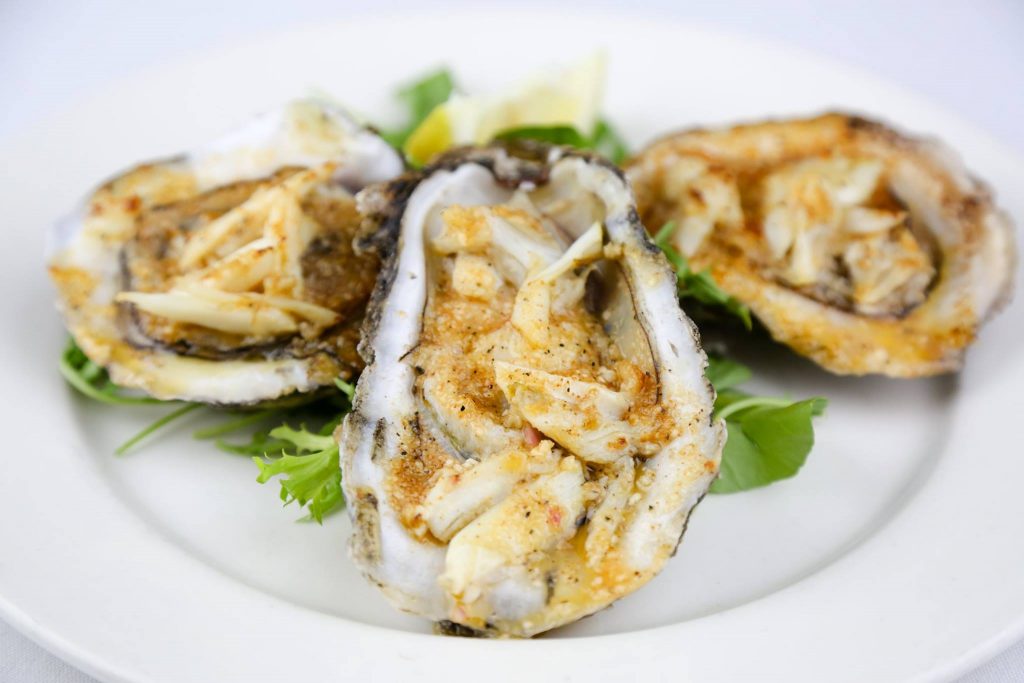
Photo courtesy of Bourbon House on Facebook
Bourbon House
144 Bourbon St.
In the heart of one of the most neon-lit, party-heavy corners of Bourbon St, the Brennan family empire has set up one of the most brilliant seafood houses in the city. The whole vibe is classic Parisian; as far as oysters go, this means you can eat at a gorgeous bar offset by art deco art and installations.
Deanie’s Seafood
841 Iberville St.
The loyalists at Deanie’s will argue tooth and nail for their oyster house over the Acme (above). We’re not going to insert ourselves into this fight, other than to say you should definitely try both. Deanie’s is known for cooked and raw oysters; when it comes to the former, we suggest trying the charbroiled version.
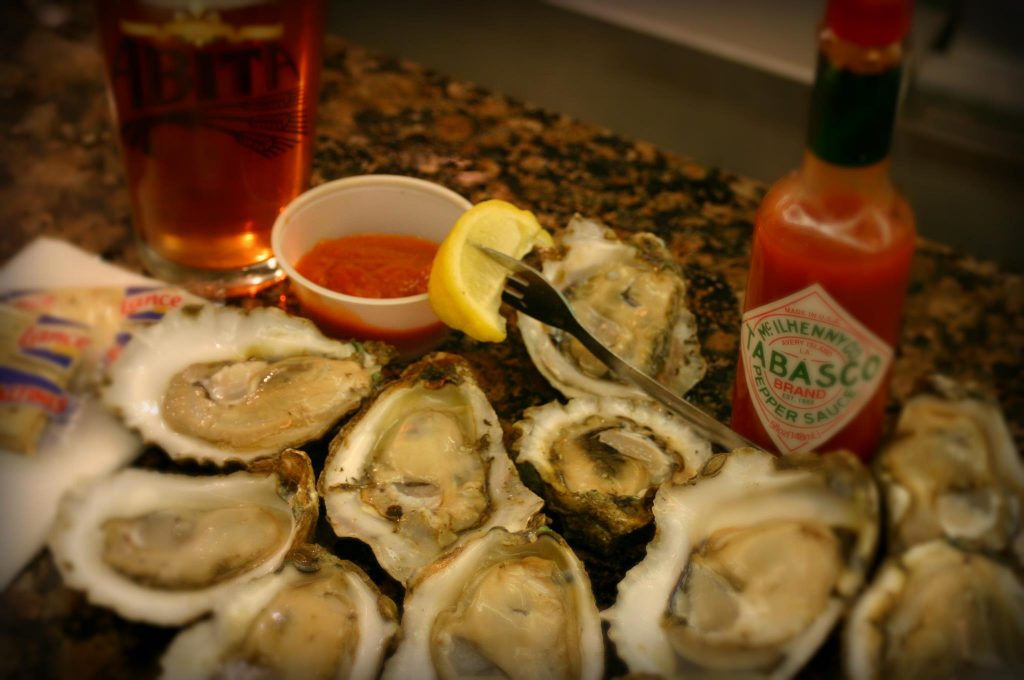
Photo courtesy of Felix’s Restaurant and Oyster Bar Inc. on Facebook
Felix’s Restaurant & Oyster Bar
739 Iberville St.
Another iconic French Quarter oyster house, Felix’s is more than seven decades old and going strong. Their formula is simple and effective: fresh seafood, good times. If you’re not keen on going raw, we also recommend the Oysters Buffalo, the Oysters Bienville, and of course, chargrilled oysters.
Galatoire’s
209 Bourbon St.
One of the great grand dames of Creole cuisine, Galatoire’s is classy, but not so classy that folks don’t like coming here to polish off several bottles of vino and several platters of oysters. That said, they cook their oysters in exceptional Creole style here; as we mention above, Oysters Rockefeller are never a bad idea.
GW Fins
808 Bienville St.
Fins is one of the cream of a crop of restaurants that look to rethink the best of New Orleans seafood while paying homage to the classics. If they’re on the menu, try the cold-smoked oysters, which come out sizzling to your plate — an utterly unforgettable seafood experience.
Mr. Ed’s Oyster Bar & Fish House
512 Bienville St.
You can get oysters raw, charbroiled, or served as a spicy shooter here, among other methods. The menu features a half dozen ways of preparing the shellfish. The rest of the menu is rounded out by big portions of Louisiana staples like blackened redfish, jambalaya, and shrimp Creole. If you’re in the Quarter with your kids, it’s worth mentioning that the atmosphere is considerably family-friendly.
Pêche
800 Magazine St.
Head into the Warehouse District to eat at one of the country’s great restaurants, a seafood house that has claimed several James Beard awards. The raw bar here is absolutely phenomenal; chef and co-owner Ryan Prewitt takes a lot of time to source only the best bivalves from select oyster providers, which means the shells you slurp here have more flavor and character than the average Gulf Coast specimen.
Royal House
441 Royal St.
We’ve got a lot of love for the Royal House’s elegant, classical dining room, which hearkens guests to Gatsby-esque levels of indulgence. The raw bar here is a brilliant gift from the culinary gods, but you should also give the Oysters Royale (topped with seafood stuffing and baked into little dollops of awesome) a whirl.
Tableau
616 St. Peter St.
This is yet another castle in the Brennan culinary kingdom. Oysters aren’t always a regular feature on the menu, but when this kitchen decides to get creative with bivalves, the innovation they bring to Creole classic recipes is nothing short of mouth-watering. We know folks who have had oysters brochette here that have lodged in their gastronomic subconscious like a delicious fever dream.
Verti Marte
1201 Royal St.
What, you think oysters always have to be served on a plate or at a raw bar? They’re also delicious when wrapped in wax paper and served on two slices of New Orleans-style French bread. We refer, of course, to the fried oyster po’boy — and Verti Marte serves up an exemplary version.
Are you planning to spend some time in New Orleans soon? To stay close to all the action, book a historic boutique hotel in the French Quarter at FrenchQuarter.com/hotels today!
Related Articles
JOIN THE NEWSLETTER!
Where to Get the Best Gumbo in the French Quarter
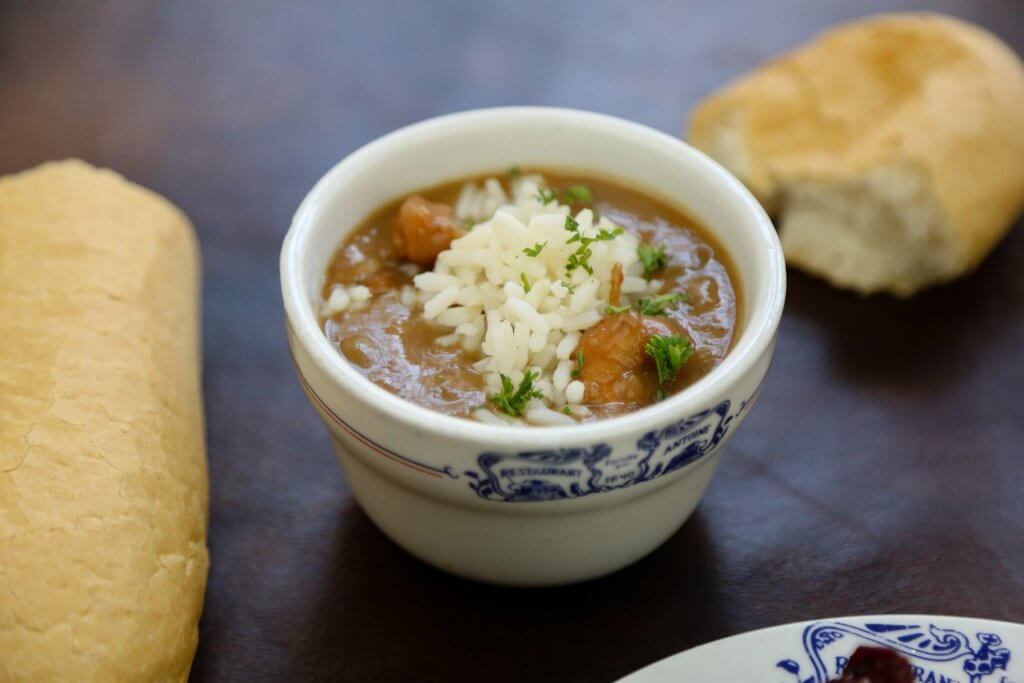
Photo courtesy of Antoine’s Restaurant on Facebook
When it comes to gumbo, surely you’ve heard, “First, you make a roux” as a conversation starter. Roux is a traditional base for gumbo — flour and fat, browned together with seasonings. Just like gumbo is a blend of cultures and influences, including French, African, Caribbean, and Native American, the word “gumbo” comes from the Choctaw Indian “kombo” — filé, or powdered sassafras — and the African word “kingumbo,” which means okra. Both filé and okra are used as thickeners in gumbo.
From roux, dozens of variations of gumbo could spring: with smoked meats like duck, rabbit, and Andouille sausage in a darker roux; with tomato or no tomato; with okra or without; with lighter roux; and with seafood like shrimp and crabmeat. Often the “holy trinity” of local cooking is used too: bell pepper, celery and onion. Gumbo z’herbes (“green gumbo”) may or may not come with meat, but its vegetarian version, though not found often in New Orleans restaurants, holds its own with various greens like collards, mustard or turnip greens, spinach, chard, and kale.
A bowl of steaming gumbo served over rice is perfection anytime, but the fall, in particular, belongs to gumbo, when okra is in season and the heat lets up. In New Orleans, excellent gumbo is easy to find. The chefs tend not to deviate too much from the classic Cajun and Creole recipes. The difference is whether you like your gumbo laden with meat or seafood; with dark roux or a lighter roux; with an Abita draft or a crafted cocktail; and among chandeliers and gilded mirrors or in a dive bar.
Most restaurants include at least two versions on the menu, the meat and the seafood. You can get a cup alone, or a cup with half of a po-boy, if you don’t want to commit to a bowl. With our picks for the French Quarter you would want to, though. From fine dining to casual, these restaurants feature different kinds of gumbo, at different price points. Most have gumbo recipes on their websites, so you can try to recreate your own.
Acme Oyster House
724 Iberville St.
This popular chain often has a line out the door at its Iberville St. location, but that’s because Acme’s Creole/Cajun classic menu of oysters, po-boys and gumbo is that good. Try a cup of the seafood gumbo with shrimp and crab, or the chicken and Andouille version. Or get the New Orleans Medley, to sample gumbo, jambalaya, red beans and rice, and grilled smoked sausage all at once. Acme also serves up half of po-boy and a cup of gumbo combos. Chase yours with an oyster shooter of vodka or an oyster-topped Bloody Mary.
Antoine’s
713 St. Louis St.
You can’t go wrong with a classic Creole seafood gumbo served on the dinner and Sunday jazz brunch menus at this legendary restaurant. Try it with Oysters Rockefeller, Antoine’s signature dish created in 1889. Established in 1840, Antoine’s is the country’s oldest family-run restaurant, with 14 dining rooms, some of which bear names of Carnival krewes, and a who’s who roster of distinguished guests.
Arnaud’s
813 Bienville St.
Staying true to the classic Creole cuisine since its inception in 1918, Arnaud’s offers two gumbos (with chicken and Andouille sausage, or seafood) on both its dinner and jazz brunch menus. You can eat in one of the elegant dining rooms, or dine in the Jazz Bistro while you listen to live Dixieland jazz presented by The Gumbo Trio (Thursdays through Saturdays).
Coop’s Place
1109 Decatur St.
If you want a quick, inexpensive meal any time of day or night, with some local color thrown in, Coop’s Place is unbeatable. Located on the always-busy stretch of Decatur Street, Coop’s is a no-frills bar and restaurant with a surprisingly extensive menu. One of the standouts is the dark-roux seafood gumbo. It comes with Coop’s own dark roux, okra, filé powder, shrimp, oysters, and crab claws. (You can ask for extra seafood.) Follow the gumbo with Coop’s excellent rabbit and sausage jambalaya. Coop’s is popular with locals and tourists, so it can get busy and loud. Please also note that it’s 21 and older only, even the restaurant seating area, because of the video poker machines on the premises.
Galatoire’s
209 Bourbon St.
This beloved institution serves two classic Creole gumbos for under $15 per bowl. The seafood okra gumbo is packed with shrimp and oysters plus okra, made with shellfish stock and light roux. The shredded duck and Andouille sausage gumbo is made with dark roux, duck stock, and the “trinity” — celery, bell pepper and onion.
Gumbo Shop
630 St. Peter St.
It wouldn’t be right not to include Gumbo Shop. After all, the name says it all. Gumbo Shop serves up three gumbos: seafood okra, chicken and Andouille, and gumbo z’herbes. Gumbo z’herbes isn’t a common sight on the New Orleans restaurant menus (unless you head to the legendary Dooky Chase’s in Tremé), so this may be your chance to try this concoction. It’s made with green stock and is laden with various greens, such as mustard or collard, turnips, and spinach. Gumbo Shop offers lots of other Creole and Cajun staples and has a lovely courtyard.
Kingfish
337 Chartres St.
Kingfish pays tribute to the Huey P. Long era with a contemporary spin on the Southern classics and signature cocktails. The restaurant’s gumbo is made with duck and Andouille sausage and is served with steamed white rice. Pair it with a Sazerac or Pimm’s Cup during Governor Hours (happy hour).
Mr. B’s Bistro
201 Royal St.
The award-winning Mr. B’s Bistro is the city’s mainstay for high-end Creole dining, run by the Brennan family. There are two gumbos on Mr. B’s lunch, jazz brunch, and dinner menus. The seafood gumbo is a classic with shrimp, crabmeat and okra. Gumbo Ya-Ya, a house specialty, is a Cajun country-style gumbo made with dark roux, lots of Creole spices, chicken, and Andouille sausage.
Restaurant R’evolution
777 Bienville S.
R’evolution’s seafood gumbo, made with scallion rice, is a solid choice, but it’s “Death by Gumbo” you’ll want. And, at $20, it’s totally worth it. This dish is much talked about and documented on social media, and it keeps receiving accolades from national food and travel magazines and websites. Death by Gumbo is Cajun style, with dark roux, presented with a whole semi-boneless quail set in the middle of the bowl, plus Andouille sausage, filé, rice, and poached oysters.
Vacherie
827 Toulouse St.
We recommend Vacherie’s chicken and Andouille gumbo, served with grilled French bread with an option to add boudin balls or potato salad. Vacherie Restaurant & Bar is located inside Hotel St. Marie and focuses on homestyle Cajun and regional fare using local ingredients.
Are you planning to spend some time in New Orleans soon? To stay close to all the action, book a historic boutique hotel in the French Quarter at FrenchQuarter.com/hotels today!
Related Articles
JOIN THE NEWSLETTER!
Try the Best Jambalaya in the French Quarter
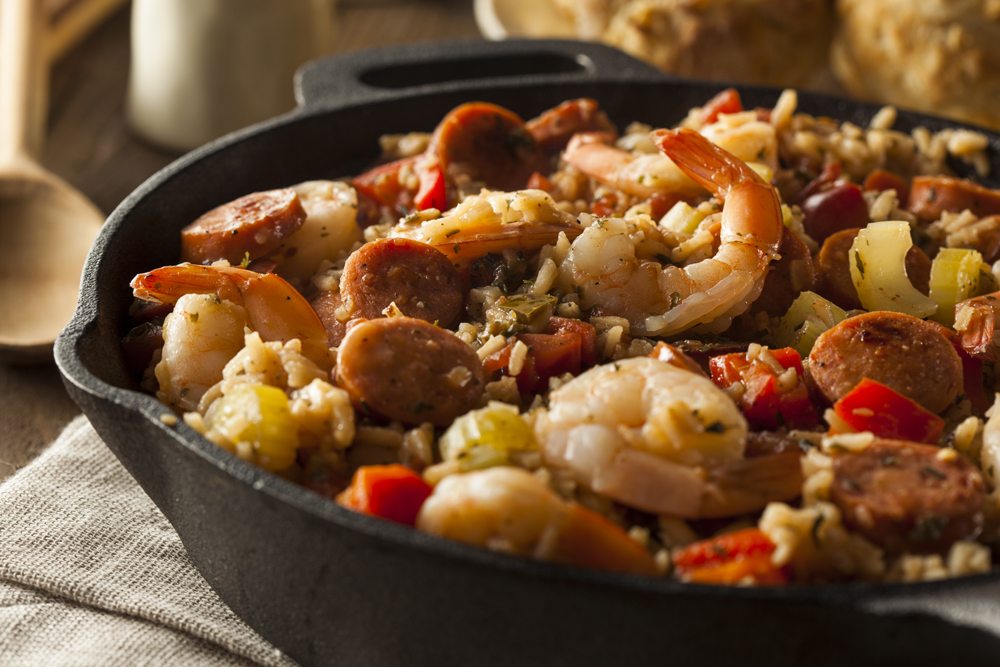
Just like with gumbo, when you ask a local where the best jambalaya comes from, they’ll likely respond, “My kitchen” (or “My mama’s kitchen”). That’s not very helpful, however, when you have no access to the said kitchen. Luckily, local restaurants serve up top-notch jambalaya if you know where to look. And look you must, because tasting great jambalaya could be a transcending experience. Precede it with a cup of gumbo laced with okra (in season in the fall), and you got bliss.
Jambalaya is a New Orleans staple that has absorbed French, Spanish, African, and Native American influences. Legend has it that it was the result of the Spanish settlers attempting to make paella, but with tomatoes and without the hard-to-find saffron.
It’s a one-pot dish that traditionally incorporates stock, meat, seafood, long-grain rice, and vegetables (like the “holy trinity” also used in gumbo — bell pepper, onion and celery). The main distinction is that the Creole version has tomatoes and the Cajun recipe doesn’t. The frequent inclusion of Andouille sausage is the result of the French influence on this iconic dish.
Just like gumbo, good jambalaya is not that hard to find on the menus of French Quarter restaurants. Here are a few of our favorite picks.
Coop’s Place
1109 Decatur St.
We’ve already recommended this no-frills bar/restaurant for its dark-roux seafood gumbo, but it’s Coop’s Creole jambalaya that is truly outstanding. It’s packed with local seasonings and comes with boneless rabbit, smoked pork sausage, plus tomatoes and the trinity.
You can get a cup or a bowl, but we recommend the supreme version — with shrimp, crawfish and Coop’s own tasso (spicy cured pork used in Cajun cooking and often referred to simply as Cajun ham). Coop’s excellent Cajun fried chicken plate comes in a variety of pieces and is served with jambalaya and coleslaw. Pasta jambalaya also makes an appearance, with shrimp, smoked sausage and tasso.
Coop’s is popular with locals and tourists, so it can get busy and loud. Please also note that it’s 21 and older only, even the restaurant seating area, because of the video poker machines on the premises.
Gumbo Shop
630 St. Peter St.
Gumbo Shop’s award-winning gumbos take the spotlight, including the rarely-seen vegetarian version, but don’t overlook other Creole staples at this French Quarter mainstay. Gumbo Shop’s jambalaya is served as an entree and a side, but also as part of the sweeping Creole dinner package. Pair it with one of the three gumbos, and you’re set.
Evangeline
329 Decatur St.
This relative French Quarter newcomer is family-owned and features fresh, seasonal Louisiana cuisine that’s sourced locally. Evangeline’s traditional jambalaya comes with chicken and sausage cooked in a stock made in-house. There’s courtyard seating, too. And don’t stop at jambalaya either, as the menu is chockful of the iconic Creole and Cajun staples.
Mother’s
401 Poydras St.
Although this legendary eatery is located outside of the French Quarter on Poydras Street in CBD, not including it would do a disservice. You might appreciate Mother’s casual, cafeteria-style approach, and the po-boys and jambalaya are a must. Mother’s had been around since 1938, becoming a famous hangout for the working crowd, and, during and after World War II, the U.S. Marines. For over 20 years, Mother’s also proudly employed a legendary cook, Miss Oda Mae Peters.
“Jerry’s Jambalaya” on the menu was named after one of the owners and chefs Jerry Amato, who had ruled Mother’s in the late 80s. It’s done Creole style, with tomatoes, medium spicy, and you can try it in four size options, from a cup to a heaping plate, or as part of the combo platter with seafood and sides.
Napoleon House
500 Chartres St.
At Napoleon House, the jambalaya comes with a bit of history. The restaurant is housed in a historic landmark on Chartres Street, dating back to the 1700s, with the unique ambiance of old-world New Orleans. The original owner, Nicholas Girod, who was Mayor of New Orleans from 1812 to 1815, hoped to provide refuge for the exiled Napoleon Bonaparte. The 2,300 sq. ft. worth of rooms on the second floor were designated to become Napoleon’s apartments. The unique interior is fit for the emperor indeed, and there’s a spacious courtyard for dining as well.
The spicy Creole jambalaya at Napoleon House comes with chicken and sausage and can be ordered as an appetizer or as a side. Consider pairing with the restaurant’s famous muffuletta and washing it down with its signature drink, Pimm’s Cup.
New Orleans Creole Cookery
508 Toulouse St.
This dark and lovely restaurant, located on a quiet block of Toulouse Street, has exposed brick, a patio, an oyster bar, and live jazz. The menu is classic Cajun/Creole, with lots of boiled seafood and Creole and Cajun versions of gumbo. The charbroiled oysters are some of the best in the city, and the full bar features hurricanes (listed by strength category from 1 to 5) and other signature drinks like bacon Bloody Mary. The chicken and sausage jambalaya is Cajun style (offered both as a starter and an entree). There’s also a vegetarian version, not something many restaurants offer.
The Original Pierre Maspero’s
440 Chartres St.
With its huge, always-open windows, this casual Cajun restaurant on the corner of St. Louis and Chartres Streets is a prime spot for people-watching. The building that houses the restaurant is one of the oldest in the French Quarter, dating back to 1788. Legend has it Andrew Jackson met with the Lafitte brothers here when it was a coffee house, to figure out the plan for the Battle of New Orleans. The blackened chicken and Andouille sausage jambalaya can be ordered as a standalone or part of the Crescent City Sampler. It’s prepared Cajun style and you can substitute chicken with shrimp.
Are you planning to spend some time in New Orleans soon? To stay close to all the action, book a historic boutique hotel in the French Quarter at FrenchQuarter.com/hotels today.
Related Articles
JOIN THE NEWSLETTER!
New Orleans’ Legendary Fried Chicken Joints
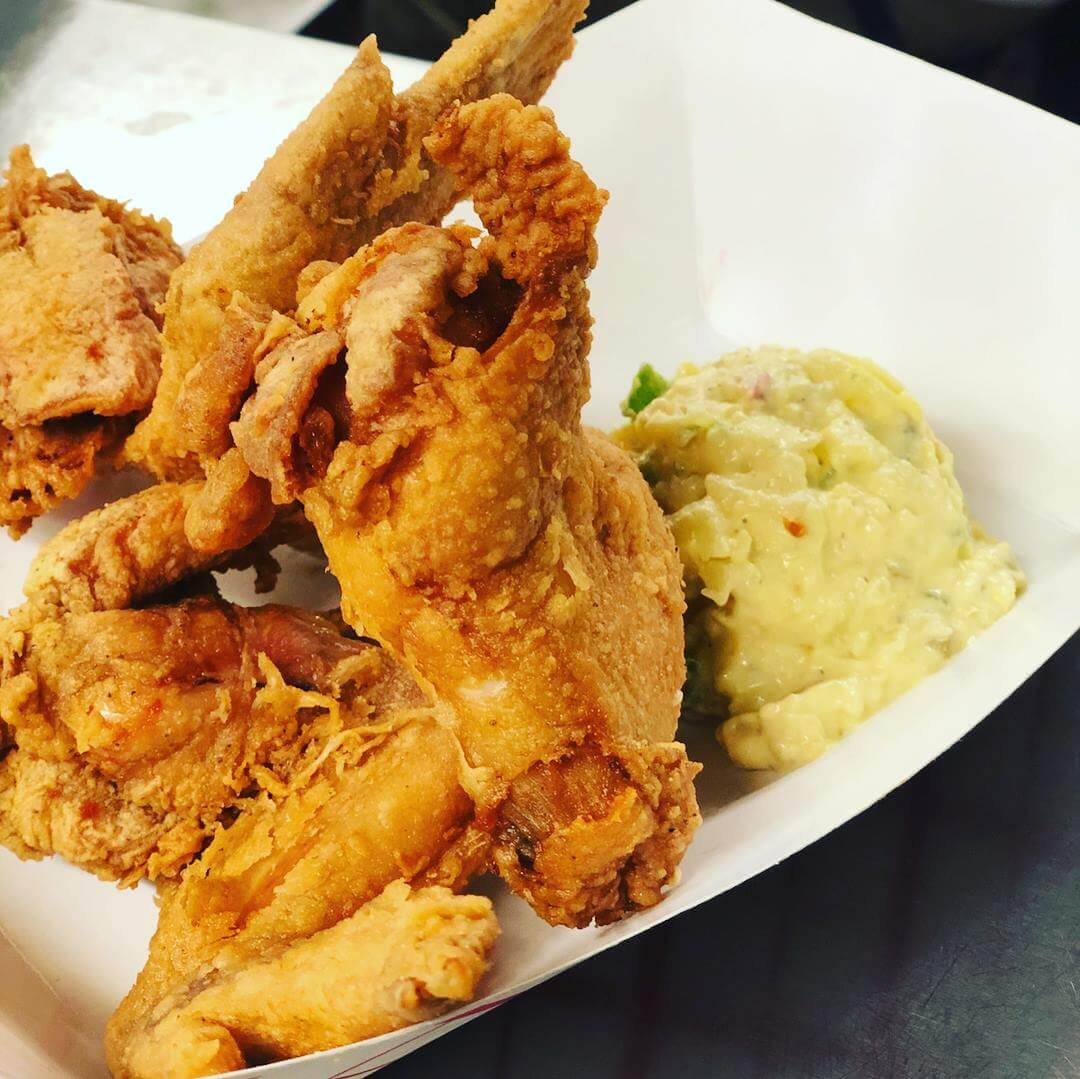
Photo courtesy of The Original Fiorella’s Cafe on Facebook
There’s no greater evidence of New Orleanians’ passion for fried chicken than the Fried Chicken Festival. This year, the free festival will take place on September 30-October 1, 2023, at the Lakefront. There will be music, cooking demos, eating contests, activities for kids… and, of course, delicious fried chicken from dozens of local vendors. In honor of the Fried Chicken Festival, here is our shortlist of just a few of the best New Orleans chicken joints.
Brothers Food Mart
Citywide
Gas-station fried chicken is a thing, and Brothers does it really, really well. While the company has many locations across New Orleans, its 148 Carondelet St. location is said to have the best fried chicken. It’s crispy, it’s not greasy, and it’s super crunchy.
Coop’s Place
1109 Decatur St.
One of the French Quarter’s bright stars and mainstays is the always bustling Coop’s, a no-frills bar and restaurant with an extensive and excellent menu that goes way beyond bar-food grub. The hands-down standout is Cajun fried chicken, made with Coop’s own seasoning blend. Pair it with Coop’s famous seafood gumbo, or rabbit and sausage jambalaya, and you’ll understand what we’re talking about.
Dooky Chase’s
2301 Orleans Ave.
This iconic Tremé institution is a treasure and an international destination for many reasons, including its late, great chef and owner Leah Chase’s legacy in the New Orleans culinary world, the unbelievable (and not easy to find) gumbo z’herbes, and its contribution to the Civil Rights Movement. Dooky Chase’s fried chicken is a mainstay, along with shrimp Clemenceau and po-boys, and it’s incredible.
McHardy’s Chicken & Fixin’
1458 N. Broad St.
This tiny, always-bustling takeout spot efficiently churns out even huge party orders of its legendary chicken. It’s crisp, with a touch of peppery heat. Get yours with some classic Cajun/Creole sides like red beans and rice or fried okra.
McKenzie’s Chicken in a Box
3839 Frenchmen St.
McKenzie’s Chicken in a Box is grab-and-go (there are no tables) local favorite. It’s been serving delicious, crunchy fried chicken since 1952, making it a Gentilly institution. Some locals would say it has the best chicken in New Orleans.
Popeyes Louisiana Kitchen
Citywide
Come on, you can’t write an homage to New Orleans’ fried chicken without including the locally founded chain that put this meal on the map. Launched in Arabi in 1972 by the larger-than-life late restaurateur Al Copeland, Popeyes took off when it launched its signature spicy seasoning blend. Now, the multinational chain boasts over 2,600 locations across 30 countries, and its red beans and rice, coleslaw, and biscuits are almost as famous as its chicken. Popeyes is a taste of home, no matter where you are — but it somehow doesn’t taste as spicy at locations outside Louisiana.
Raising Cane’s Chicken Fingers
Citywide
Is it the soft Texas toast that comes with every order? The slightly pinkish Cane’s Sauce? The tart lemonade? Or the hefty, made-to-order chicken fingers? Nobody knows for sure, but something on the menu of this Baton Rouge-born fast-food chain has won over millions of “Caniacs.” The fast-growing Raising Cane’s is also one of the Fried Chicken Festival sponsors — which means that you can get a taste of the famous Cane’s fare if you’re attending this year.
The Original Fiorella’s Cafe
5325 Franklin St.
The Original Fiorella’s reopened its doors in 2016, after a 17-year absence from the New Orleans dining scene — and it did so with a bang. Hot and tender, with a golden exterior, Fiorella’s signature fried chicken hasn’t changed. Past Fried Chicken Festival winner Fiorella’s is back at the fest this year — so you can taste its gem of a recipe and judge for yourself.
Are you planning to spend some time in New Orleans soon? To stay close to all the action, book a historic boutique hotel in the French Quarter at FrenchQuarter.com/hotels today.
Related Articles
JOIN THE NEWSLETTER!
Best Muffulettas in the French Quarter and Nearby
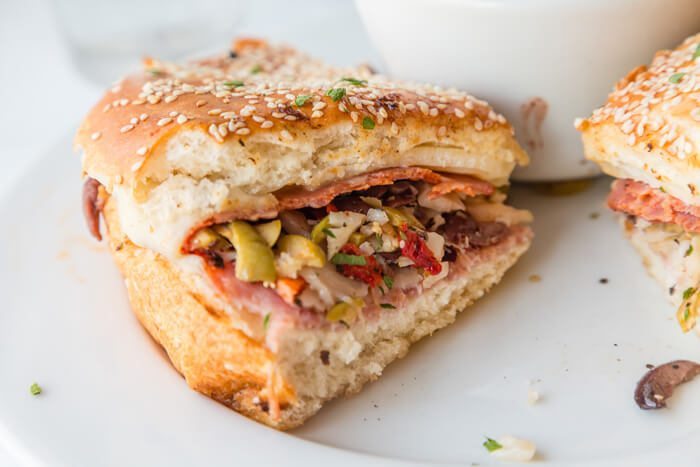
One of New Orleans’ most celebrated creations is a tall, bready Sicilian-Cajun invention that reflects the city’s diverse cultural and culinary heritage. The muffuletta goes back to the 19th century, when the French Quarter was sometimes referred to as “Little Palermo,” and its Sicilian working-class population consisted of laborers, dockworkers, fishermen, and farmers. A few of the immigrants opened grocery stores and bakeries and catered to the Sicilians who lived and worked in the Quarter and parts of Treme.
What’s in a muffuletta?
“Muffuletta” (pronounced “muffuLOTta” and sometimes also spelled as “muffaletta”) comes from the bread known in Sicily under that name. Traditionally, the sandwich is made with the sesame-crusted wheel of bread, Italian salami and ham, cheese (usually provolone and Swiss), and olive salad. The olive salad consists of finely chopped green and black olives, celery, cauliflower, carrots, sweet peppers, pepperoncini, onions, capers, vinegar, and garlic. Spices and herbs are also added (parsley, oregano, etc.).
Where does it come from?
The invention of this oversized sandwich is credited to Salvatore Lupo, the proprietor of Central Grocery & Deli on Decatur Street in the French Quarter. The “Home of the Original Muffuletta” opened in 1906 and has been selling the sandwich for over a century. Legend has it that the Italian farmers and laborers would buy what became the ingredients for the muffuletta for lunch from Lupo’s store (and other vendors in the French Quarter), and eat them separately. Lupo decided to assemble them into a sandwich, tweaked a few components — and muffuletta was born.
The variations outside tradition
Like with most signature New Orleans creations, opinions run strong when it comes to any deviation from the tradition. Some maintain that muffuletta is a cold-cut sandwich, period. Others had been serving it hot, like the James Beard Award-winning chef Donald Link, owner of Cochon Butcher. Yet others offer it hot and cold (Verti Marte).
Liuzza’s Restaurant & Bar in Mid-City also popularized the “Frenchuletta,” a muffuletta version served on French bread. PIZZA domenica, with three locations in New Orleans, has muffuletta pizza with provolone, cured meats and olive salad.
There are seafood versions, like the one that was at some point offered at Parran’s Po-Boys & Restaurant, which has locations in Metairie and Kenner. Parran’s “Original Seafood Muffuletta” came with fried oysters, shrimp and catfish, dressed with housemade Cajun mayo. Then there was the muffuletta King Cake from Cartozzo’s Bakery in Kenner, with grated Romano cheese dyed in Mardi Gras colors and sprinkled on top of the savory King Cake ring.
Some call the non-traditional versions blasphemy; others say they’re not muffulettas but “something else.”
Who does it best?
Central Grocery
The original cold-cut version.
Central Grocery’s made-to-order muffulettas have the visitors and the locals lining up ever since Salvatore Lupo stuffed his first sandwich. Today’s muffuletta at Central Grocery keeps it traditional: Genoa salami, Holland ham, mortadella (bologna), the secret-recipe olive salad, and Swiss and provolone cheese — served on an 8-inch round bread.
The sprawling, old-fashioned grocery store is still run by the same Lupo family, selling imported Italian delicacies and the housemade olive salad by the jar. You can eat in at the counter, or take your muffuletta to go (the Woldenberg Park by the river is a great spot for a picnic). The visitors of the city have been known to pack their muffulettas for a flight or a drive home, but you don’t have to — Central Grocery ships nationwide.
Cochon Butcher
Melted cheese, meats are cured in-house.
Another New Orleans joint that serves its muffulettas hot (unless you request yours cold) is Cochon Butcher in the Warehouse District, chef Donald Link’s companion to Cochon. The much-praised Cochon muffuletta comes on a Sicilian roll, with housemade giardiniera. All the meats are cured in-house.
Frank’s Restaurant
Baked, with melted cheese and toasted bread.
“The home of the other muffuletta,” Frank’s has been around for over 50 years, serving a different kind of muffuletta to scores of its loyal fans just down the block from Central Grocery. The crucial difference is that Frank’s “World Famous Original Muffuletta” is baked and served with toasted bread and melted cheese. Frank’s is also known for its po-boys and classic Italian fare. The downstairs looks like a deli with a to-go counter, but the second-floor dining room is spacious and has balcony seating if you want to dine in with a view of the French Quarter.
Napoleon House
Big enough to share, house specialty.
Muffuletta is one of the specialties at Napoleon House, which is housed in a historic landmark on Chartres Street that dates back to the 1700s and has the unique ambiance of old-world New Orleans. The traditional muffuletta is served warm, and is big enough for two people (you can also get it in half and quarter sizes). Wash it down with the restaurant’s signature drink, the Pimm’s Cup.
Verti Marte
Overstuffed, generous on meat, served cold or hot.
The tiny, beloved Verti Marte on Royal Street is open 24/7 for takeout or delivery. Verti Marte gets a lot of love for its long breakfast menu and epic po-boys, but don’t discount the “Mighty Muffuletta.” It’s overstuffed with ham, salami and cheese, but — here’s the catch — it could be served hot or cold. So if you’re not from the cold-cut purist camp and won’t mind your cheese melty and your meat warm, this is one of the best places to try the hot version.
Are you planning to spend some time in New Orleans soon? To stay close to all the action, book a historic boutique hotel in the French Quarter at FrenchQuarter.com/hotels today!
Related Articles
JOIN THE NEWSLETTER!
Try the Best Coffee in the French Quarter and Nearby
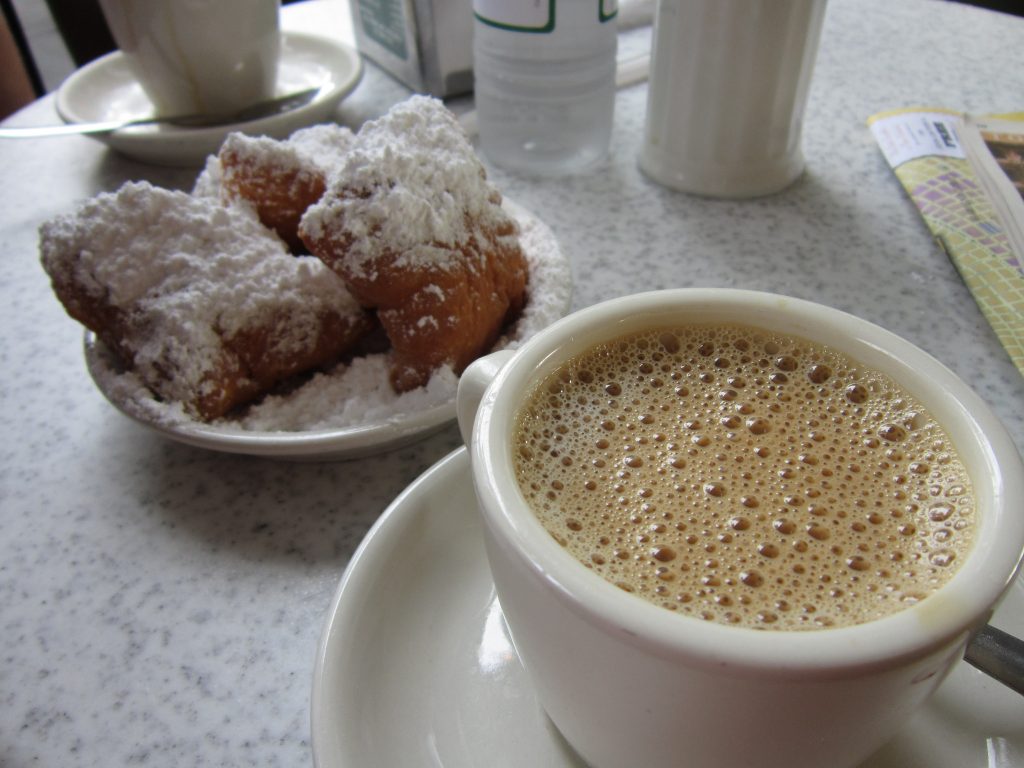
Beignets and cafe au lait at Cafe Du Monde by Selena N. B. H. on Flickr
As befits one of the most European and Caribbean cities in the country, New Orleans loves coffee. This city was sipping on the stuff long before it became popular across the rest of the USA, and some of our oldest cafes remain destinations in and of themselves. Of course, there are some modern coffee houses here as well that you don’t want to pass up. Here are a few of our favorites.
In the French Quarter
New Orleans can be a romantic place for a cup of coffee, but there are parts of the French Quarter where the balconies and street music make for pure caffeinated magic.
Cafe Beignet
334 Royal Street
There’s plenty of ridiculous debate over who serves the better beignet, Cafe Fu Monde or Cafe Beignet (just have both and decide for yourself), but when it comes to the venue, it’s hard not to make the case for the Royal Street location of Cafe Beignet (there are three more across the French Quarter). It’s shady, relatively quiet, and you can get some excellent people-watching in.
Cafe Du Monde
800 Decatur Street
What, you thought we’d let you go without recommending one of the world’s most iconic cafes? If we’re being brutally honest, the lines here can be a little much when they stretch almost a city block, but the chicory coffee and beignets are truly excellent, there’s live music all around, and the service is efficient.
Envie Espresso Bar & Cafe
1241 Decatur Street
The people-watching at Envie Espresso Bar & Cafe (also referred to as Cafe Envie) is some of the best in the city, and that’s saying something. Pull up a chair at an outdoor table, order a coffee drink (or a drink drink, or both; Envie has good cocktails and can do an excellent Irish coffee), and just watch life in the Quarter: musicians, lovers, poets, rowdy folks on a weekend trip, and everyone in between.
French Truck Coffee
700 Canal Street
French Truck is one of the city’s most well-known brands, with multiple locations across New Orleans. The company roasts its own beans and also has an extensive wholesale operation (you might have seen the products in local stores). The Canal Street location is super convenient if you’re staying in the French Quarter.
Outside of the French Quarter
Many of the best coffee shops in New Orleans are located within easy walking or biking distance from the French Quarter. Here are some of our picks.
Coast Roast Coffee & Tea
2381 St. Claude Avenue (Bywater)
Located within St. Roch Market, Coast Roast produces some fine pour-over coffee and espresso drinks. With all of that said, frozen coffee is quite simply the best frozen coffee we’ve had anywhere, full stop. That sort of superlative statement gets thrown around a lot in these sorts of articles, but we really will stand by this assertion: Coast Roast frozen coffee is sweet, strong and stupendous. It’s good whatever the external climate is, but on hot, humid days (which, let’s be honest, aren’t unheard of in New Orleans), it’s seriously heaven in a cup.
Coffee Science
410 S. Broad Street (Mid-City)
The business’ motto is: “We’ll brew with science, you enjoy the coffee!” The fact that Coffee Science is helmed by Tom Oliver, who’s been in the coffee business for over 30 years, truly backs it up. The space is generous, there are weekend flower popups from a local vendor, special events are held in the big backyard, and the wi-fi is strong. Coffee Science is located on a busy thoroughfare near the courthouse complex at Tulane and Broad, and there’s plenty of parking.
HEY Coffee Co.
2606 St. Louis Street (Tremé)
The Uptown favorite HEY! Café & Coffee Roastery recently expanded to the edge of Tremé, right on the Lafitte Greenway bike path and park, also moving all roasting to the new location. HEY’s progressive stance is manifested in such touches as the eco-friendly pasta, not plastic, straws — and the coffee speaks for itself.
Flora Gallery & Coffee Shop
2600 Royal Street (Marigny)
The atmosphere can’t be beat. The overgrown lushness of the outside trees, fading paint and cracked walls are like the Platonic ideal of the sort of space where you’d expect to find a local musician or writer.
Satsuma Cafe
3218 Dauphine Street (Bywater)
Whether the owners like it or not, Satsuma is one of the most recognizable icons of the “new” Bywater, which is ironic, as old neighborhood locals and transplants alike tend to congregate here. That’s because Satsuma is simply a lovely place: they’ve got good coffee, excellent breakfast and lunch food, a pretty outdoor courtyard, a cool, airy interior, and they’re totally family-friendly. Bring the kids, and don’t leave without trying the quiche of the day. (Satsuma has two more locations in New Orleans.)
The Bean Gallery
637 N. Carrollton Avenue (Mid-City)
This Mid-City favorite remained popular over the years, while many other coffee shops have come and gone. The reasons, to name a few, are good wi-fi, ample outdoor and indoor seating, staying open till midnight Thursdays through Sundays (it also opens at 6:30 a.m. every day), and a long menu of bagel and croissant sandwiches, panini, specialty teas, and sweets.
The Orange Couch
2339 Royal Street (Marigny)
This spare, minimalist cafe is nonetheless populated with warm, inviting staff. The coffee is made with care and attention, and the menu is more creative than your average espresso outpost; mochi ice cream sits aside a delicate, moist tea bread that makes for a fairly perfect light lunch. This is also a popular spot for those looking to get some work done or just to enjoy the wi-fi.
The Station Coffee Shop and Bakery
4400 Bienville Street (Mid-City)
This Mid-City joint is inviting, with interesting architecture and decor. All baked goods are made in-house with high-quality ingredients, and the coffee menu is varied.
Who Dat Coffee Cafe
2401 Burgundy Street (Marigny)
While there’s not a ton of space to bust out a laptop and be all professional in this little Marigny cafe, if you can score a comfy seat in the little alcove room, you’ve got one of the best little workspaces in New Orleans (or if you’re in a group, an excellent spot for a caffeine-fueled discussion). Bonus: The attached restaurant is pretty excellent; try the corncakes.
Are you planning to spend some time in New Orleans soon? To stay close to all the action, book a historic boutique hotel in the French Quarter at FrenchQuarter.com/hotels today!
Related Articles
JOIN THE NEWSLETTER!
Light My Fire: The Spectacle and Tradition of Café Brûlot
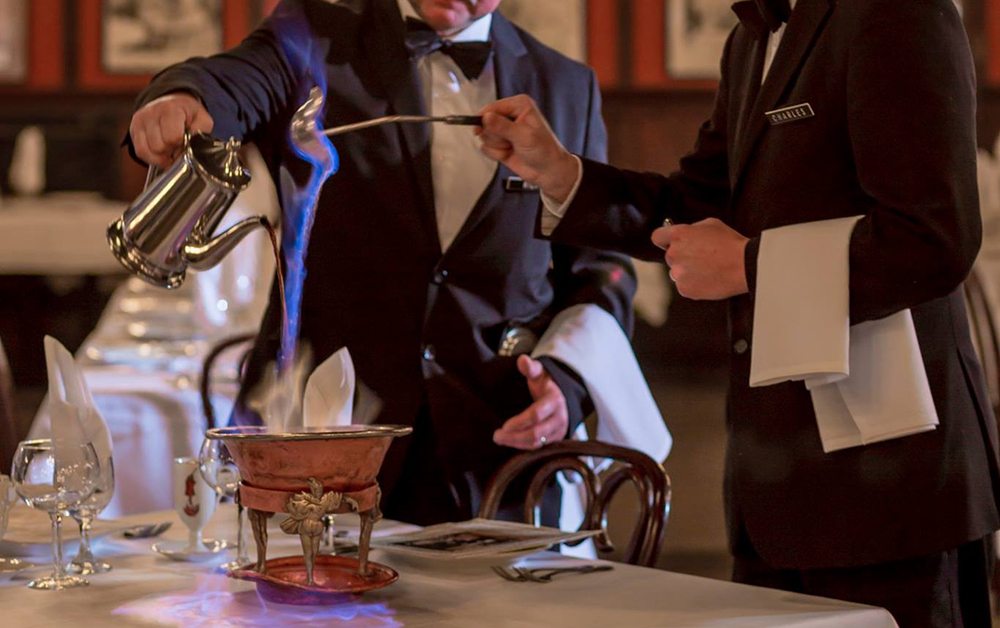
Photo courtesy of Antoine’s Restaurant on Facebook
A lot of towns have dinner theater, but in New Orleans dinner is theater. This is especially true in the old-line Creole restaurants where locals and visitors partake in dining experiences as cultural and theatrical as they are culinary. In these terms, the New Orleans postprandial libation known as café brûlot can be considered a special effect, or maybe even pyrotechnics.
What Is Café Brûlot?
This is no ordinary after-dinner drink, nor is it readily available at ordinary restaurants. It’s made with specialized equipment, in portions large enough for at least several servings, and it comes with a choreographed tableside preparation sure to temporarily supersede conversation not only at your table but usually at all those within earshot.
The name, of course, comes from the French: café, or coffee, and brûlot, which can mean either “highly seasoned” or “incendiary,” both of which prove apt for this singular drink. A list of ingredients in the classic café brûlot recipe helps illuminate its elaborate nature. Most preparations call for an orange peel cut precisely as one long, intact spiral; a lemon peel cut into strips; sugar, cloves and cinnamon; cognac or brandy and hot, strong black coffee. Most importantly, the drink requires fire.
The Flaming Finale: How Café Brûlot Is Made
It ends up tasting like very thick, sweet coffee with the deep citrus and clove flavors mellowing the sweetness. Many diners say they prefer the second cup to the first, since the concoction has had time to steep a little more. Though the drink is ordered year-round, café brûlot’s hot temperature and rich, bold flavor make it a particularly enjoyable way to end dinner on a cooler winter night. It is especially popular as a finale to a big holiday meal, such as the New Orleans Reveillon feast.
However delicious and reviving it may be, getting there is more than half the fun when it comes to café brûlot.
The recipe is so special, it requires its own exotic equipment to make. This includes a silver bowl, a circular tray and a long-handled ladle. The brandy mixture is poured into the bowl, which is surrounded by a small amount of alcohol in the circular tray. The coffee is brought to the table steaming hot and added to the brandy. In many cases, the lights of the dining room will then be dimmed to accentuate the impending dance of flame that accompanies the final steps of this drink’s dramatic preparation.
The waiter ignites the alcohol with a match and allows the fire to heat up the contents of the bowl, which grows increasingly aromatic. The waiter then dips the long ladle into the mixture, ignites it from the flame surrounding the bowl, and carries the flame back to set off the brandy.
Quickly, while the mixture is still flaming, the waiter will hold the spiraled orange peel over the bowl with a fork and proceed to ladle the flaming coffee mixture down the peel repeatedly. The technique creates a mesmerizing ribbon of blue-gold flame that inspires choruses of oohs and ahhs around the dining room whenever it is done right.
Where to Try Café Brûlot in the French Quarter
The spectacular preparation gives the term mixed drink a whole new meaning, and it is certainly a job best left to experienced professionals. Want to try café brûlot? Here are our top recommendations for the French Quarter.
Antoine’s Restaurant (713 St. Louis St.) lays claim to the invention of café brûlot, and gives the credit to Jules Alciatore, son of founder and namesake Antoine Alciatore, sometime in the 1890s. The drink enjoyed special popularity during Prohibition, when coffee provided cover for the then-contraband alcohol.
Café brûlot also became a house specialty of other old-line Creole restaurants, as it remains today, including Galatoire’s Restaurant (209 Bourbon St.), Broussard’s (819 Conti St.), and Arnaud’s Restaurant (813 Bienville St.), which happened to open for business the same year the federally-mandated deprivations of Prohibition began.
Restaurant lore at Arnaud’s holds that special coffee drinks were also used there to disguise liquor libations. Today, however, ordering a café brûlot with all its attendant ceremony and ritual is one of the worst ways to be inconspicuous in a formal New Orleans dining room. It is also one of the most memorable ways to cap off a glorious New Orleans meal.
Don’t miss out on all the excitement the French Quarter has to offer all year round, round the clock! Book your room at any of these historic hotels today.
Related Articles
JOIN THE NEWSLETTER!
Best Pizza in the French Quarter
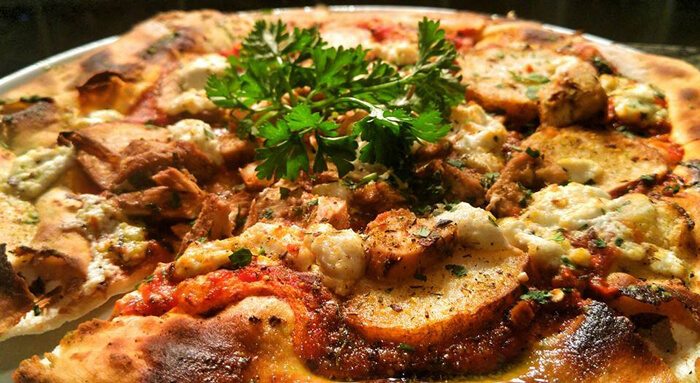
Photo courtesy of Louisiana Pizza Kitchen on Facebook
Good pizza isn’t hard to find in New Orleans, although it’s not one of the city’s signature offerings, like gumbo or a po-boy. There’s no loyalty to any specific style (deep dish vs. thin crust, for instance), and the pizzerias run the gamut of high-end to classic parlors to casual neighborhood spots to the late-night after-party soakers.
The French Quarter has its share of restaurants that serve decent to excellent pizza, with a wide variety of vegetarian options and specialty pies that highlight the local ingredients and take advantage of the abundance of Gulf seafood, Cajun meats, and other culinary staples New Orleans is known for. Here are several options in the French Quarter we recommend.
Crescent City Pizza Works
407 Bourbon Street
At this late-night Bourbon pizzeria pies have names like Big Cheesy and Chicken Bacon Krunch. The BBQ pork pizza will chase your hangover away with pulled pork, two types of cheese, cinnamon apples, and a generous serving of Sweet Baby Ray’s BBQ sauce. The ever-popular Chizzaburger combines Angus beef, onions, mozzarella, pickles, ketchup, and mustard.
Louisiana Pizza Kitchen
95 French Market Place
Each location of this local chain is owned and operated separately, and this Louisiana Pizza Kitchen fires its gourmet pizzas in a wood-burning stove. Many ingredients are locally sourced, all the meats are organic and free-range, and a whole-wheat crust is available. The restaurant also has an extensive wine list and a selection of specialty beers from local microbreweries.
Specialty pizzas showcase the local cuisine with their takes on staples like crawfish etouffee and jambalaya. The standouts are a fried oyster pizza, topped with P&J oysters, artichokes, and grilled eggplant; and a smoked salmon pizza that inventively combines tomatoes, capers, caviar, red onions, and cream cheese.
Mona Lisa
1212 Royal Street
This is a great dine-in option if you want romantic and laid-back with some New Orleans flair. The building that houses the restaurant has undergone many reincarnations, housing a machine works business and a cigar shop at one time. It still retains its charm and historic elements. The restaurant’s walls are adorned with dozens of paintings and drawings of the Mona Lisa, some of which came from the patrons. Mona Lisa has been in the neighborhood for several decades, earning a loyal local following with its simple and solid Italian fare.
There are four vegetarian pizza options, plus the seafood one with tilapia, shrimp and baby clams. The Mona Lisa Special is a meat-lovers bliss — with pepperoni, ham, Italian sausage, and loaded with vegetables. Another popular specialty pizza is the Da Vinci, with Italian sausage, bacon, artichoke, and sun-dried tomatoes.
Vieux Carre Pizza
733 St. Louis Street
This pizza joint uses housemade dough and its own marinara sauce. Besides pizza, it has an affordable menu of pastas, sandwiches, salads, and more. One of the most popular specialty pies, the Bourbon Special, is loaded with chicken, feta cheese, spinach, and pesto. The Vieux Carre also has basic specialties like vegetarian and Hawaiian pizzas. It’s open late (3 a.m. Monday through Friday and Sunday; 4:30 a.m. on Saturday). Delivery and online ordering are also available.
Don’t miss out on all the excitement the French Quarter has to offer all year round, round the clock! Book your room at any of these historic hotels today.
Related Articles
JOIN THE NEWSLETTER!
Proof is in the Bread Pudding—Chefs Add Variety to New Orleans’ Classic Dessert
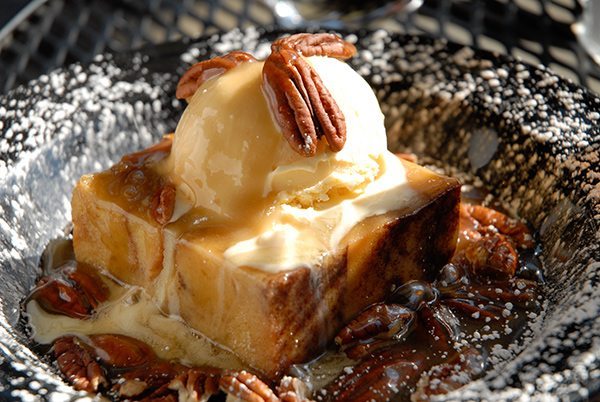
When most bread goes stale it gets tossed in the trash or fed to the birds. But for some lucky loaves, going stale is just the beginning of a transformation into bread pudding — the ambrosial dessert that is a mainstay finale at many restaurants across New Orleans.
A Quick History of Bread Pudding
Though its roots go back centuries to the thrifty domestic kitchens of Europe — where a variety of sweet and savory pudding dishes evolved from the recycling of stale bread — the distinctively Southern-style bread pudding is a dessert New Orleans has embraced and made its own.
Most such recipes start with bread soaked in a mixture of milk, eggs and sugar, which is then baked and sliced into squares or wedges. Served warm, bread pudding is usually covered in a rich, sweet sauce containing a strong dose of booze — most often bourbon.
The main appeal of the dessert, however, goes back to its first ingredient. The bready foundation nicely sops up any sauce paired with it so that each bite is infused with its flavor. The bread base — soaked in milk and eggs — also lends a soft, spongy texture to the pudding that contrasts deliciously with toppings of pecans, walnuts or raisins that often accompany the dish.
Although bread pudding is not a New Orleans (or even American) invention, it’s offered at many restaurants in the French Quarter and nearby, both the fine-dining and casual establishments. With a steady supply of French bread and no shortage of creativity, the New Orleans chefs have been concocting variations of the dessert ranging from traditional to new interpretations.
Most local chefs keep the bread pudding bread-based and sweet. Others may add their own twists to the sauce. You may also come across the savory versions, with cheese and chicken and Andouille sausage. One interpretation served in restaurants like Muriel’s is pain perdu (the “lost bread”), a Creole cross between French toast and traditional bread pudding.
Since there’s no “right” way to make bread pudding, New Orleans’ own unique versions are worth exploring. Here are our recommendations for the best bread pudding in the French Quarter and nearby.
The Traditionals
Gumbo Shop
This French Quarter casual eatery offers lots of other Cajun staples beyond its three types of gumbo and has a lovely courtyard. The bread pudding here is the traditional version, served warm, with whiskey sauce. Try it a la carte, or as part of the prix fixe Creole dinner.
Mother’s Restaurant
This legendary eatery is located outside the French Quarter on Poydras Street in CBD. Mother’s has a casual, cafeteria-style approach and had been around since 1938, becoming a famous hangout for the working crowd. The “Ferdi Special,” a baked ham and roast beef po-boy, was named after a loyal patron, and the Creole-style “Jerry’s Jambalaya” belongs to chef Jerry Amato, who had ruled Mother’s in the late 80s. The bread pudding is the traditional version, with brandy sauce.
Oceana Grill
The casual French Quarter eatery at the corner of Bourbon and Conti Streets is a solid choice for Creole and Louisiana fare like crab cakes, po-boys and gumbo. It’s open late for dinner and has a lovely courtyard. Oceana’s traditional bread pudding is served with the restaurant’s own praline rum sauce.
The Original Pierre Maspero’s
With its huge, always-open windows, this casual Cajun restaurant on the corner of St. Louis and Chartres Streets is a prime spot for people-watching. The building that houses the restaurant is one of the oldest in the French Quarter, dating back to 1788. Legend has it Andrew Jackson met with the Lafitte brothers here when it was a coffee house, to figure out the plan for the Battle of New Orleans. The traditional caramel bread pudding here consistently gets rave reviews.
Tujague’s
The iconic gem on Decatur Street hardly needs an introduction. The second oldest restaurant in the city, it was founded in 1856 and has since been offering traditional, fixed-price Creole menus to many a president and celebrity. Its famous bar takes credit for inventing the Grasshopper cocktail, and the restaurant may or may not take credit for creating brunch. Tujague’s white chocolate bread pudding is served with Maker’s Mark caramel sauce.
A Category of Its Own
Antoine’s
The Pudding de Pain de Noix de Pecan (pecan bread pudding) is as timeless and classic as the restaurant that serves it. This French-Creole fine-dining establishment probably needs no introduction. Let’s just describe the pudding: It’s a cinnamon, golden raisin, and pecan concoction topped with warm butter rum sauce. The bread used is Leidenheimer French bread. It’s also on Antoine’s famous jazz brunch menu.
Brennan’s
You probably know of Brennan’s world-famous Bananas Foster dessert, but the bread pudding at this fine-dining Creole landmark is a classic that is served with ice cream and is worth trying.
Muriel’s Jackson Square
The pain perdu version at Muriel’s comes with candied pecans and rum sauce (here’s the recipe). Enjoy it a la carte or as part of the prix fixe dinner menu. Muriel’s is elegance personified and won’t steer you wrong if you want contemporary Creole cuisine. (The menu has quite a few gluten-free items too.) The restaurant opens up onto Jackson Square, so you can enjoy people-watching in the heart of the French Quarter.
Palace Cafe
This Brennan family-owned restaurant on the busy block of Canal Street is known for its upscale Creole bistro menu and ample sidewalk seating. The restaurant’s original white chocolate bread pudding is as unique as it is popular. The chunks of white chocolate are baked inside the bread, and the whole thing is covered with warm white chocolate ganache and shaved dark chocolate. You can take a stab at the recipe from the Palace Cafe: The Flavor of New Orleans Cookbook.
Red Fish Grill
Ralph Brennan’s Red Fish Grill has been around for more than 20 years, offering a child-friendly respite in the middle of the Bourbon Street chaos. It’s known for its seafood-heavy menu and good happy hour deals on the drinks and the oysters. The well-reviewed double chocolate bread pudding is made with dark and white chocolate ganache (sauce) and chocolate almond bark. It takes about 20 minutes to prepare but it’s worth the wait.
Bread Pudding Recipe
Can’t wait until you make it to New Orleans? Try this recipe at home.
Serves 6
Ingredients: 1 loaf stale French bread 1 cup raisins 2 cups milk 3 eggs, beaten 1/2 cup melted butter 1 teaspoon vanilla 1/4 teaspoon salt 1 tablespoon cinnamon 1/2 cup brown sugar
Directions
1. Preheat the oven to 350 F
2. Rip the bread into small pieces
3. Place in a mixing bowl and cover with the milk, letting it soak for 20 minutes
4. Mash the bread into a consistent texture with no chunks
5. Add the eggs, vanilla, cinnamon, sugar, raisins, butter, and salt and mix well 5. Pour into a buttered nine-inch square baking pan and bake for about 45 minutes, until browned on top and set in the center
6. Cut into squares and serve with whipped cream
Are you planning to spend some time in New Orleans soon? To stay close to all the action, book a historic boutique hotel in the French Quarter at FrenchQuarter.com/hotels today!


